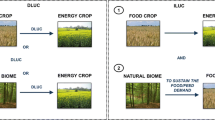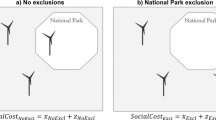Abstract
We investigate the development of stationary energy policy for the national and sub-national ecological footprint. Three carbon emission mitigation scenarios relating to the electricity sector (two different fuel mix scenarios and the rate of technological uptake) are explored. We find that the effectiveness of sub-national policy varies with global uncertainty. To be robust, policy to reduce carbon emissions from the stationary energy sector must be successful irrespective of which future eventuates and/or must be highly adaptable and responsive to different futures. We investigate the impact of emission reduction policy on other parts of the ecological footprint—energy land. Many low carbon energy production methods require large areas of land, and this exacerbates current land use competition, particularly with respect to agricultural land. We find that holistic policy development will need to identify land uses which can operate synergistically with land required for renewable energy to mitigate ecological footprint expansion as renewable energy increases. Our case study using Australia and four of its states provides a framework applicable elsewhere in the world to increase the resilience of the energy sector and agriculture.
Access this chapter
Tax calculation will be finalised at checkout
Purchases are for personal use only
Similar content being viewed by others
Notes
- 1.
The A2 storyline describes a very heterogeneous world. Population growth is high. Economic development is primarily regionally oriented and medium-low. Technological change is more fragmented and slower than in other storylines.
The B1 storyline describes a convergent world with a medium-high global population. It has rapid changes in economic structures and medium income growth. There is a globally coordinated emphasis which is on global solutions to economic, social and environmental sustainability.
The B2 storyline describes a world in which the emphasis is on local solutions to economic, social and environmental sustainability. Global population size is low and income growth is medium. Technology growth is less rapid.
Abbreviations
- IPCC:
-
Intergovernmental Panel on Climate Change
- CO2:
-
Carbon dioxide
- SRES:
-
Special Report on Emissions Scenarios
- STIRPAT:
-
Stochastic Impacts by Regression on Population, Affluence and Technology
- IPAT:
-
Impact, Population, Affluence and Technology
- OLS:
-
Ordinary least squares
- IEA:
-
International Energy Agency
- GDP:
-
Gross domestic product
- ABARE:
-
Australian Bureau of Agricultural and Resource Economics
- MT:
-
Megaton
- KWh:
-
Kilowatt-hour
- CSP:
-
Concentrated solar power
- CCS:
-
Carbon capture and storage
- Ha:
-
Hectare
- GWh:
-
Gigawatt-hour
- NG:
-
Natural gas
- Geoth:
-
Geothermal
- Bioms:
-
Biomass
- PV:
-
Photovoltaic
- Qld:
-
Queensland
- WA:
-
Western Australia
- SA:
-
South Australia
- VIC:
-
Victoria
- CO2-e:
-
Carbon dioxide equivalent
References
ABARE (2009) Energy in Australia 2009. Department of Resources, Canberra
Albrecht G, Higginbotham N, Freeman S (2001) Transdisciplinary thinking in health social science research: definition, rationale, and procedures. In: Higginbotham N, Albrecht G, Connor L (eds) Health social science: a transdisciplinary and complexity perspective. Oxford University Press, Melbourne
Australia’s Centre for International Economics (2007) Geodynamics says ‘it has hottest rocks on earth’. The Australian
Australian Greenhouse Office (2008) National Greenhouse Gas Inventory 2006
Barrett DJ (2001) Component ecological footprint: developing sustainable scenarios. Impact Assess Proj Appraisal 19:107–118
Clarke L, Weyant J, Edmonds J (2008) On the sources of technological change: what do the models assume? Energy Econ 30:409–424
CSIRO (2011) LCA shows full picture on energy use
de Araujo MS, De Campos CP, Rosa LP (2007) GHG historical contribution by sectors, sustainable development and equity. Renew Sust Energ Rev 11:988–997
de Vries BJM, van Vuuren DP, Hoogwijk MM (2007) Renewable energy sources: their global potential for the first-half of the 21st century at a global level: an integrated approach. Energy Policy 35:2590–2610
Diesendorf M (2005) Towards Victoria’s clean energy future. Clean Energy Future Group Environment Victoria
Dietz T, Rosa E (1997) Effects of population and affluence on CO2 emissions. Proc Natl Acad Sci 94:175–179
Ehrlich PR, Ehrlich AH (1990) The population explosion. Simon & Schuster, New York
Energy Watch Group (2007) Coal: resources and future production. Energy Watch Group, Berlin
Feron P, Paterson L (2011) Reducing the costs of CO2 capture and storage (CCS). CSIRO, Canberra
Frees EW, Miller TW (2004) Sales forecasting using longitudinal data models. Int J Forecasting 20:99–114
Gagnon L, Bélanger C, Uchiyama Y (2002) Life-cycle assessment of electricity generation options: the status of research in year 2001. Energy Policy 30:1267–1278
Garnaut R (2011) The Garnaut review 2011: Australia in the global response to climate change. Commonwealth of Australia, Department of Climate Change and Energy Efficiency
Gawell K, Reed M, Wright PM (1999) Preliminary report: geothermal energy, the potential for clean power from the earth. Geothermal Energy Association, Washington, DC
GFN (2013) Ten-in-ten initiative. Global Footprint Network
GWEC (2008) Global wind energy outlook. Global Wind Energy Council, Brussels
Harding R, Hendriks CM, Faruqi M (2009) Environmental decision making: exploring complexity and context. The Federation Press, Sydney
Hastie T, Tibshirani R (1993) Varying-coefficient models. J Roy Stat Soc Ser B 55:757–796
Holm A, Blodgett L, Jennejohn D, Gawel K (2010) Geothermal energy: international market update. Geothermal Energy Association, Washington, DC
Hoogwijk MM, Van Vuuren D, De Vries BJM, Turkenburg WC (2007) Exploring the impact on cost and electricity production of high penetration levels of intermittent electricity in OECD Europe and the USA, results for wind energy. Energy 32:1381–1402
IEA (2012) International Energy Agency
IHA, IEA-HA, ICOLD, CHA (2000) Hydropower and the world’s energy future. International Hydropower Association, IEA Hydropower Agreement, International Commission on Large Dams, and Canadian Hydropower Association, Compton, UK, Paris, France, and Ottawa, Canada
IPCC (n.d.) IPCC special report on emissions scenarios
Jennings V, Lloyd-Smith B, Ironmonger D (1999) Household size and the poisson distribution. J Popul Res 16:65–84
Jorgenson AK, Clarke B (2010) Assessing the temporal stability of the population/environment relationship in comparative perspective: a cross-national panel study of carbon dioxide emissions, 1960–2005. Popul Environ. https://doi.org/10.1007/s11111-010-0117-x
Klein Goldevijk GK (2001) Estimating global land use change over the past 300 years: the HYDE database. Global Biogeochem Cycles 15:417–433
Lenzen M, McBain B (2012) Using tensor calculus for scenario modelling. Environ Model Softw 37:41–54
Lenzen M, Schaeffer R (2012) Historical and potential future contributions of power technologies to global warming. Clim Chang 112:601–632
Lenzen M, Dey C, Foran B, Widmer-Cooper A, Ohlemuller R, Williams M, Wiedenmann J (2013) Modeling interactions between economic activity, greenhouse gas emissions, biodiversity and agricultural production. Environ Model Assess 18:377–416
Lenzen M, McBain B, Trainer T, Jütte S, Rey-Lescure O, Huang J (2016) Simulating low-carbon electricity supply for Australia. Appl Energy 2016:553–564
Louthean R (2007) Big energy role for central Australia’s hot rocks. Geoscience Australia
Lu X, McElroy M, Kiviluoma J (2009) Global potential for wind-generated electricity. PNAS 106:10933–10938
McBain B, Lenzen M, Wackernagel M, Albrecht G (2017) How long can global ecological overshoot last? Glob Planet Chang 155:13–19
McDonald GW, Patterson MG (2004) Ecological footprints and interdependencies of the New Zealand regions. Ecol Econ 50:49–67
McDonald RI, Fargione J, Kiesecker J, Miller WM, Powell J (2009) Energy sprawl or energy efficiency: climate policy impacts on natural habitat for the United States of America. PLoS One 4:e6802
Milman A, Short A (2008) Incorporating resilience into sustainability indicators: an example for the urban water sector. Glob Environ Chang 18:758–767
Mohr SH, Evans GM (2009) Forecasting coal production until 2100. Fuel 88:2059–2067
Nakićenović N, Swart R (2000) Special report on emissions scenarios. Intergovernmental Panel on Climate Change, Geneva
Norberg J, Cummings GS (2008) Complexity theory for a sustainable future. Columbia University Press, New York
Nourry M (2008) Measuring sustainable development: some empirical evidence for France from eight alternative indicators. Ecol Econ 67:441–456
Pacala S, Socolow R (2004) Stabilisation wedges: solving the climate problem for the next 50 years with current technologies. Science 305:969–972
Paish O (2002) Small hydro power: technology and current status. Renew Sust Energ Rev 6:537–556
Rosenfeld AH, Bassett DA (1999) The dependence of energy efficiency improvement (AEEI) on price and policy. The conference on climate change and ozone protection
Trieb F, Langniß O, Klaiß H (1997) Solar electricity generation - a comparative view of technologies, costs and environmental impact. Sol Energy 59:89–99
UNEP (2010) Solar and wind energy resource assessment (World Development Report 2010 - development and climate change. United Nations Environmental Program
van der Zwaan B, Rabl A (2004) The learning potential of photovoltaics: implications for energy policy. Energy Policy 32:1545–1554
World Energy Council (2004) 2004 survey of energy resources. Elsevier, London
York R, Rosa E, Dietz T (2003) STIRPAT, IPAT and ImPACT: analytic tools for unpacking the driving sources of environmental impacts. Ecol Econ 46:351–365
Acknowledgements
We thank our research partners the Global Footprint Network, Forestry Corporation of NSW and the State of Environment Reporting units for the NSW, Victorian, Queensland, Tasmanian, South Australian and Western Australian state governments. We thank Olivier Rey Lescure for his invaluable assistance with GIS.
Funding
This work was supported by an Australian Research Council Linkage Grant [grant number: LP0669290].
Author information
Authors and Affiliations
Corresponding author
Editor information
Editors and Affiliations
Rights and permissions
Copyright information
© 2021 Springer Nature Singapore Pte Ltd.
About this chapter
Cite this chapter
McBain, B., Lenzen, M., Albrecht, G., Wackernagel, M. (2021). Future Transitions to a Renewable Stationary Energy Sector: Implications of the Future Ecological Footprint and Land Use. In: Banerjee, A., Meena, R.S., Jhariya, M.K., Yadav, D.K. (eds) Agroecological Footprints Management for Sustainable Food System. Springer, Singapore. https://doi.org/10.1007/978-981-15-9496-0_5
Download citation
DOI: https://doi.org/10.1007/978-981-15-9496-0_5
Published:
Publisher Name: Springer, Singapore
Print ISBN: 978-981-15-9495-3
Online ISBN: 978-981-15-9496-0
eBook Packages: Biomedical and Life SciencesBiomedical and Life Sciences (R0)




